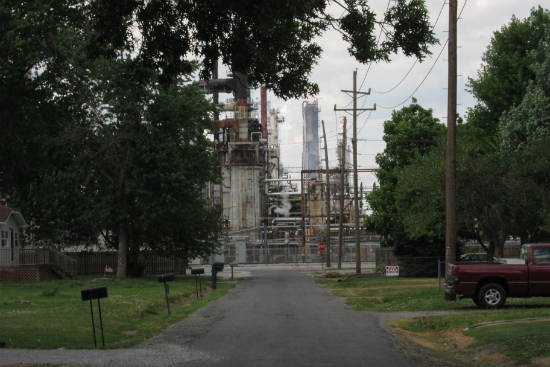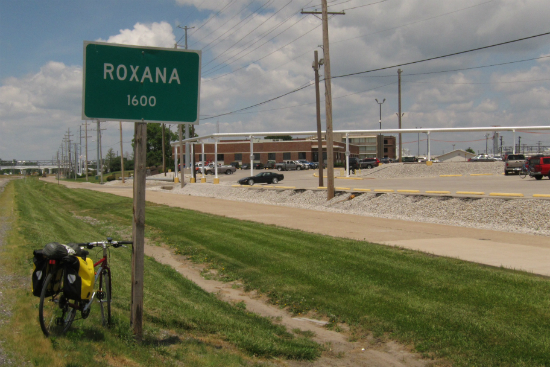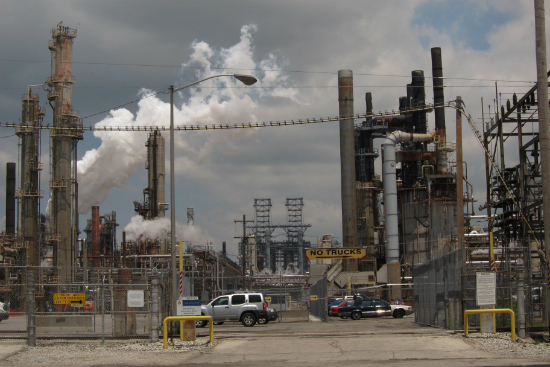
Towers of industry from an oil refinery peek above small houses and trees, forming the background of two small villages in southern Illinois.
Just 20 miles northeast of St. Louis, MO, the Wood River refinery became the sixth largest in the United States after it completed an expansion in 2011. For me and my research project, the site is significant as a destination for Canadian oil from the Keystone Pipeline. For the guards that stopped me for taking photos, this oil facility is a possible target for terrorists, which makes it a national security concern. For most of the 1,500 people who live in Roxana and 2000 in South Roxana, the 2200-acre complex is just a presence.

"It's there and you smell it once in a while, but that's about it," said South Roxana Mayor Kenney Beasley, who has lived in town since 1957.
While the Roxanas sprang up because of the refinery, which Shell Oil built in 1917, most of the locals don't work for the refinery, said Marty Reynolds, Roxana Public Works Director. "At one time, there was a significant number working there," Reynolds said. "But the wages at the refinery are so high that people can live in nicer places than Roxana." Getting a job at the refinery also tends to be difficult, Reynolds said. The hiring process involves a one-year training course, technical tests and screening procedures. "Many [locals] don't qualify or don't want to spend the time," he said.
The most direct impact of the refinery on the local community comes in the form of property taxes, said John Navin, economics professor at Southern Illinois University in Edwardsville. This year, the village of Roxana received $2.1 million dollars in taxes from the refinery. The tax dollars are especially important to the school district because public education in Illinois is primarily funded by property taxes, he said.
But to understand the larger picture regarding the refinery's impact, Navin said I needed to consider the larger regions surrounding the refinery. "Don't just focus on the little village of Roxana," he said. "There are people who live in surrounding towns like Alton and Edwardsville because they work for the refinery or have jobs connected to the refinery."
Recently, the largest impact the refinery had on the community was its four year, $3 billion dollar expansion project. Navin, who researched the local impact of the project, said the value to the region from taxes, work going to local construction firms, and increased spending from workers is $1.5 billion for the four years.
The expansion project can also be considered one of the indirect impacts Canadian oil has had on the community. According to the ConocoPhillips website, the upgrade was specifically undertaken to build equipment allowing the refinery to process heavy, sour (high sulfur) crude oil, such as Canadian crude. While the refinery had been running Canadian crude for over 20 years, using existing pipelines before the Keystone was completed, there is more crude, and more expected, than can be processed.

The Wood River refinery has been using Canadian crude to replace expensive, light, sweet (low sulfur) crude that came from the Middle East and Latin America. "Canadian crude is a better business choice right now," said an anonymous spokesperson at the refinery. "The refineries that can take advantage of the stable supply and lower cost of Canadian crude would be more competitive." The spokesperson added that some refineries that failed to upgrade closed, though no new refineries have been built since the 1970s due to laws, regulations and negative public opinion. "Even a permit to do a minor expansion at this refinery took three years to get," the spokesperson said. "And in those three years, the economic climate changed and we were almost not going to go through with it."
Since the construction occurred on land that the refinery already owned, local property was not effected. The Keystone crossed about four residential properties, Village Clerk Nona Austin said, but most of it ran through undeveloped areas. Some residents complained, but the complaints were typical of construction work, such as noise and mess, Reynolds said.
The main on-going issue the locals have with companies that owned the refinery is pollution, Reynolds said. The EPA researchers found land in Roxana has been contaminated with benzene (a carcinogen) and other toxic compounds. The EPA traced most of the toxins to a pipeline rupture from 1986 when Shell Oil owned the refinery. Shell had not addressed the issue even though the company researched it and the volatile chemicals migrated through groundwater to residential areas, which the EPA reported may expose the residents to carcinogenic compounds. The village and several villagers have filed separate lawsuits against the companies that at one time owned the refinery. But the refinery went through about six owners, so who should pay for remediation is complicated.
Despite the lawsuits against the oil companies, Reynolds said most of the locals are fine with the refinery. "I don't think people have any animosity toward the refinery," he said.
